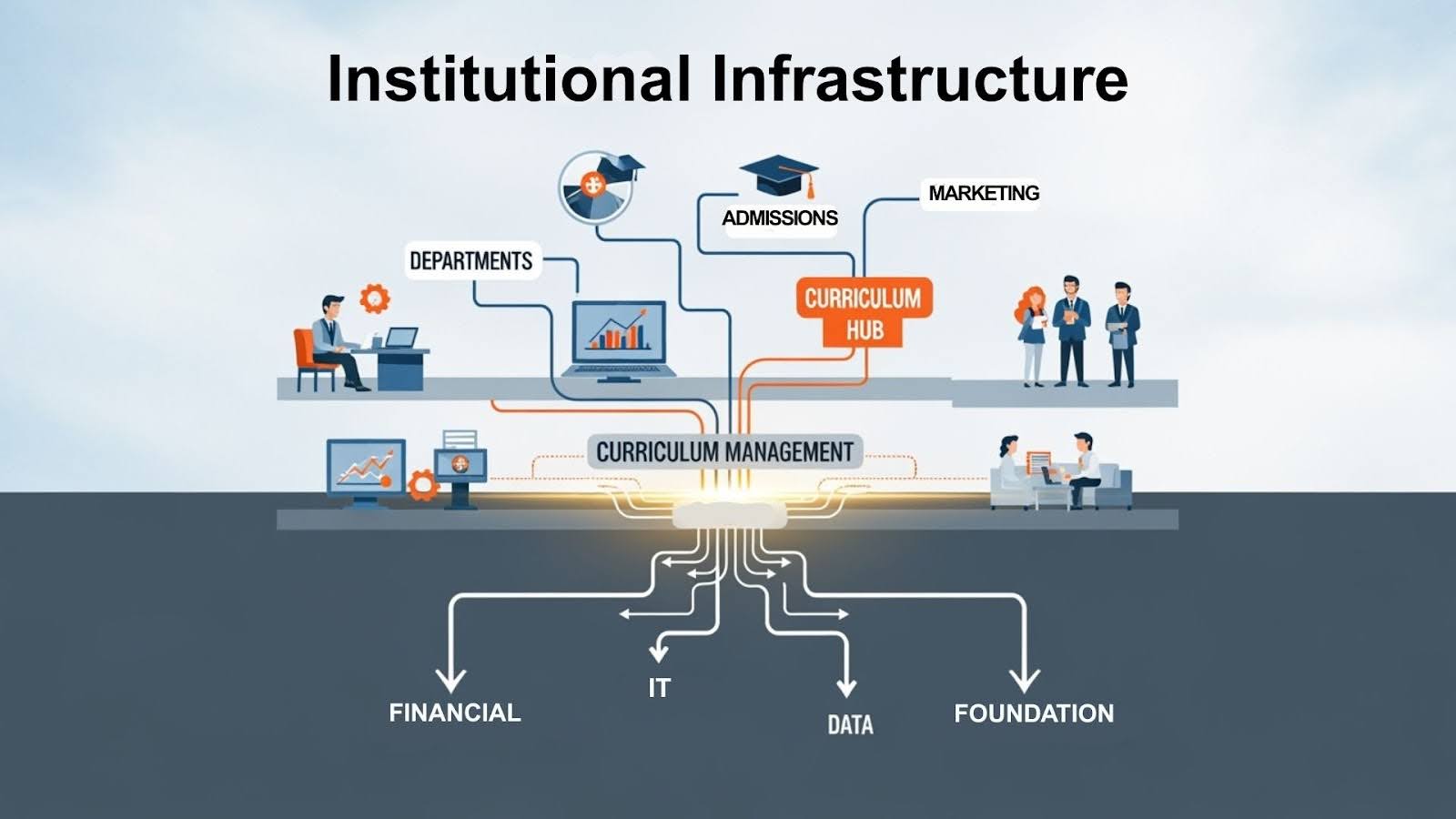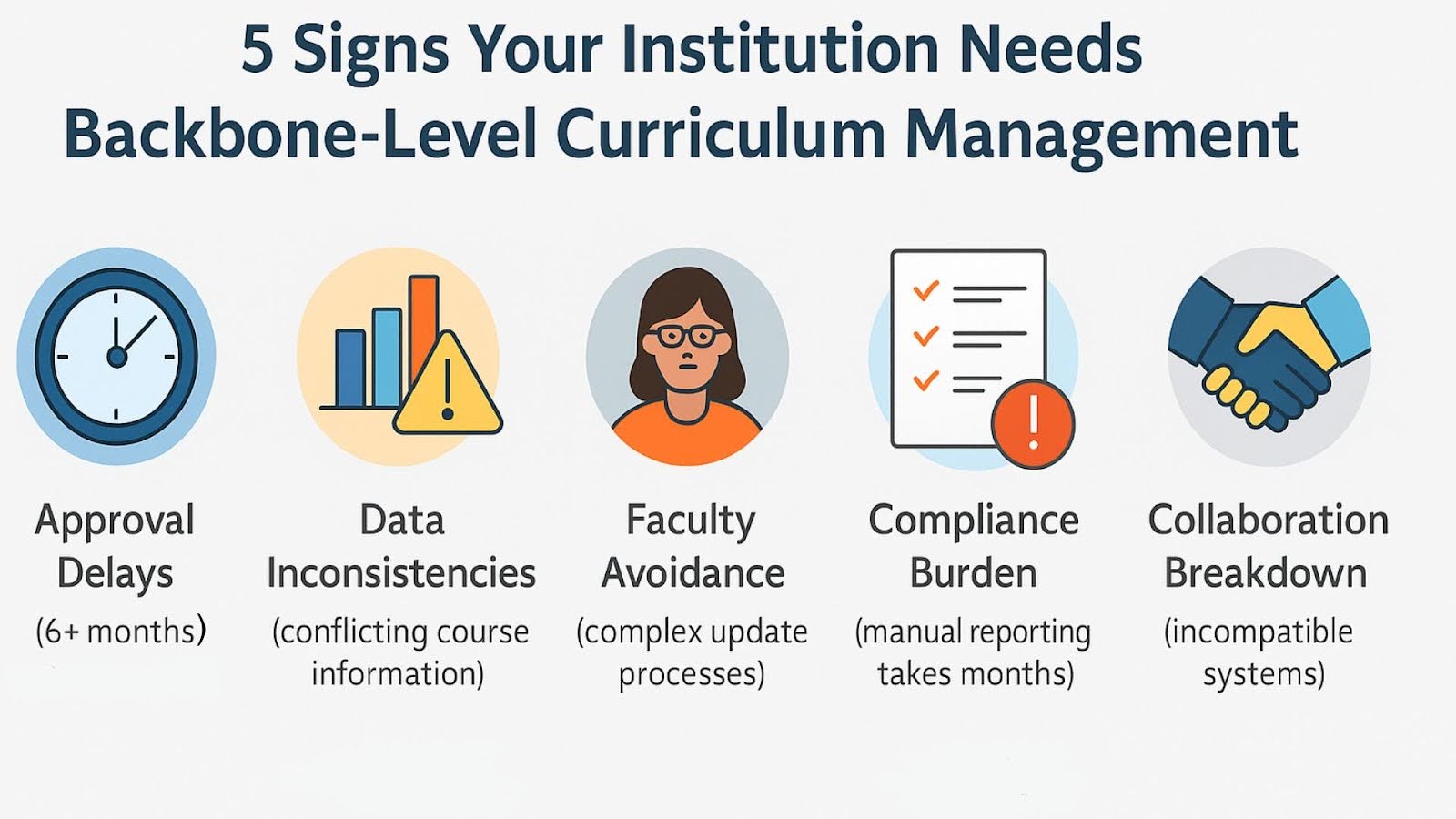Why Curriculum Management Systems are the Backbone of Higher Ed
Modern institutions can't survive without robust curriculum management systems serving as their operational foundation. Higher education software benefits institutions by:
- Reducing approval times
- Ensuring data consistency across platforms
- Enabling rapid response to workforce demands
- Supporting emerging credential pathways
Institutions that treat curriculum management as essential infrastructure rather than just software gain competitive advantages in student retention and employer satisfaction.
Higher education is facing its most challenging period in decades. The traditional college-age population will peak in 2025 and then begin a steady 15-year decline, while 38% of employers report that schools aren't sufficiently preparing students for careers in their respective industries. Amidst these mounting pressures, effective curriculum management systems (CMS) are absolutely critical to institutional survival and success.
Many institutions think of curriculum management as just another piece of higher education software when, in reality, it functions as the foundational bedrock that supports every aspect of operations. Just as you wouldn't run a university without reliable IT infrastructure or financial systems, you can't effectively manage modern higher education without a robust curriculum management system at its core.
What Makes Curriculum Management Systems the Institutional Backbone for Higher Ed?
When you examine how truly successful institutions operate, you’ll discover solid curriculum management steers the ship for institution-wide decision making and operations. How you approach curriculum management determines whether it becomes a strategic driver of growth or just another software expense.
Beyond Software – Essential Infrastructure
Think about the last time your institution's financial system went down. Class payments couldn't be processed, staff couldn't be compensated, and operations ground to a halt. A curriculum management system serves a similarly critical role, but its impact touches even more aspects of your institution.
When your curriculum system functions as true infrastructure, it becomes the single source of truth that feeds every other system on campus. Your student information system relies on it for course data. Your marketing team pulls from it for catalog updates. Faculty depend on it for approval workflows. Even facilities planning stems from the programs and courses it houses.

The difference between treating curriculum management as just another administrative tool versus essential infrastructure lies in strategic investment and institutional positioning. Infrastructure gets protected budget allocation, dedicated IT support and executive-level attention because leadership understands that operations depend on it.
The Connected Curriculum Advantage
A connected curriculum creates a seamless flow of accurate, real-time information that enables every department to make informed decisions quickly. When your curriculum management system serves as the linchpin, you eliminate the data silos that plague most institutions.
Consider how many times your marketing team has promoted outdated course information or how often students receive conflicting details about program requirements. These are problems that a robust education CMS eliminates by serving as the definitive source of truth. A connected curriculum ensures that when the nursing department updates prerequisites for a course, those changes immediately flow to advising systems, the course catalog, marketing materials and student planning tools.
This level of integration transforms how quickly you can respond to external pressures. When workforce training accounted for 36% of total EdTech funding in 2024, institutions with backbone-level curriculum management could launch new professional development programs in weeks rather than months.
How Does the Curriculum Management Backbone Support Critical Functions?
Once your curriculum functions as a unified hub, it enables capabilities that directly impact your institution's competitiveness and sustainability. This infrastructure approach transforms how quickly you can respond to market opportunities, how effectively you can demonstrate compliance to accreditors and how strategically you can make data-informed decisions.
Rapid Response to Market Demands
In 2024, the World Economic Forum predicted that 65% of elementary school children today will work in jobs that don't yet exist. This means curriculum agility is essential for higher ed’s survival.
Institutions with backbone-level curriculum management can pivot quickly when new career pathways emerge. When artificial intelligence started dominating industry conversations, universities needed to rapidly integrate AI literacy across disciplines. Those with robust curriculum management systems could map AI competencies for existing courses, identify gaps and launch new microcredentials within a single semester.
The difference becomes even more pronounced when you consider partnership opportunities. Employers want to collaborate with institutions that can respond to their training needs.
Compliance and Accreditation Foundation
Modern curriculum management systems provide built-in compliance tracking that surpasses basic record-keeping. They create audit trails that demonstrate not just what changes were made, but why they were made and how they align with institutional goals and accreditation standards.
When accreditation teams arrive for their reviews, institutions with backbone-level systems can instantly generate reports showing how specific learning outcomes connect to courses, how program changes have improved student success metrics and how curriculum development aligns with strategic planning.
The compliance benefits extend beyond accreditation. State reporting requirements, federal program compliance and professional licensing board standards all require detailed curriculum documentation. Supportive curriculum management automates much of this reporting, freeing staff time for more strategic work.
Data-Driven Decision Making
Institutions generate massive amounts of data, but most struggle to transform that data into actionable insights. Having an education CMS hub connects enrollment patterns, student success metrics, workforce outcomes and program effectiveness.
Integration enables predictive analytics that can identify which programs are likely to see declining enrollment, which courses need additional support resources and which new credential pathways show the most promise. Institutions are increasingly focused on data-informed decision-making, and curriculum management systems provide the foundation for these strategic insights.

Real-time dashboards fed by backbone-level curriculum management allow academic leaders to spot trends as they develop. For example: if first-year retention drops in engineering programs, leadership can immediately see which specific courses might be causing issues and implement targeted interventions before the problem compounds.

- Approval Delays Cost You Opportunities – If launching a new certificate program takes more than six months because of cumbersome approval processes, you're losing a competitive advantage.
- Data Inconsistencies Create Student Confusion – When students see different course descriptions in your catalog, registration system and marketing materials, it signals a lack of institutional continuity. A connected curriculum prevents these discrepancies.
- Faculty Avoid Curriculum Updates – If your faculty postpones program improvements because the proposal process is too complex, you're missing opportunities for academic innovation. Strong, secure systems make updates intuitive and transparent.
- Compliance Reporting Consumes Excessive Staff Time – If preparing for accreditation requires months of manual data compilation, your curriculum management lacks efficient functionality. Automated reporting should be standard.
- Cross-Departmental Collaboration Breaks Down – When different colleges within your university operate with incompatible systems and processes, you're missing the synergies that drive institutional success. Backbone-level systems enable seamless collaboration.
Future-Proofing Through Infrastructure Investment
Higher education will continue evolving. Microcredentials and stackable pathways are moving beyond innovative experiments and becoming standard expectations. The rise of the 60-year curriculum model means institutions must support learners across multiple life stages and career transitions.
Institutions that invest in a comprehensive education CMS as vital infrastructure position themselves to adapt to these changes. When new credentialing standards emerge, backbone systems can incorporate them seamlessly. When regulatory requirements change, the infrastructure adapts without disrupting daily operations.
Perhaps most importantly, backbone-level curriculum management enables the kind of student engagement strategies that drive retention and success. Students can see clear pathways through their programs, understand how courses connect to career outcomes and make informed decisions about their academic journeys. This transparency directly impacts student satisfaction and institutional loyalty.

As is the case with all forms of tech, higher education software is in a constant state of flux, with median IT expenditures exceeding $10 million annually for most institutions. When curriculum management is treated as a core foundation, other technology investments deliver greater impact because they're built on a stronger base.
Frequently Asked Questions
What's the difference between curriculum management software and a curriculum management system that serves as an institutional backbone?
Software is a tool you use to accomplish specific tasks, while core infrastructure supports all institutional operations. Backbone-level curriculum management integrates with every other system, provides real-time data flow and enables institution-wide decision making, not just course approval workflows.
How long does it take to implement a backbone-level curriculum management system?
Implementation timelines vary based on institutional complexity, but most institutions report meaningful benefits within 12 months. The key is treating implementation as an infrastructure project with executive support, not just a departmental software installation.
Can smaller institutions benefit from backbone-level curriculum management?
Absolutely. Smaller institutions often benefit more because they have fewer systems with which to integrate and can see institution-wide impacts faster. The efficiency gains and improved student experience often justify the investment, even with smaller budgets.
How does backbone-level curriculum management support innovation in higher education?
By providing real-time data integration and streamlined approval processes, backbone systems enable rapid response to market demands, quick program launches and evidence-based curriculum improvements. Innovation requires agility, and agility requires infrastructure that can adapt quickly.
Embrace Strong Curriculum Management Infrastructure
The future of higher education belongs to institutions that understand the difference between managing curriculum and building a robust curriculum framework. As demographic pressures intensify and workforce demands evolve, you need backbone infrastructure that enables institutional transformation.
Modern Campus provides the foundation that transforms how institutions attract, engage and retain learners for life. Book a demo today to experience the difference for yourself.
Last updated: October 27, 2025



